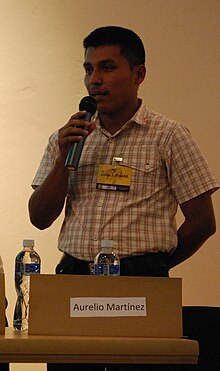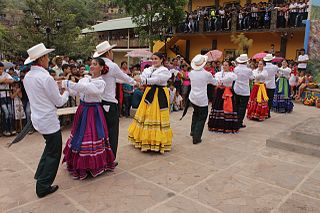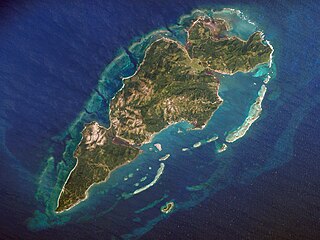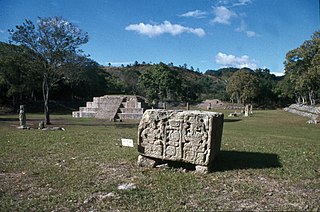| Languages of Honduras | |
|---|---|
| Official | Spanish |
| Indigenous | Amerindian languages |
| Minority | Garifuna |
| Foreign | English |
There are a number of languages spoken in Honduras though the official language is Spanish.
| Languages of Honduras | |
|---|---|
| Official | Spanish |
| Indigenous | Amerindian languages |
| Minority | Garifuna |
| Foreign | English |
There are a number of languages spoken in Honduras though the official language is Spanish.
In Honduras, dozens of languages were spoken before the Spanish conquest. The language most spoken was the Lenca language; after the conquest, the most spoken language became Castilian.
By far the most widely spoken language in the country, spoken natively by the vast majority of citizens regardless of ethnicity. Honduran Spanish is considered a variety of Central American Spanish.
The language of the Honduran Lencas is considered an extinct language. Because it is already in danger of extinction, it has a population of 300 to 594 semi-speakers. Its geographical location is between the western departments of Honduras, as they are: Lempira, Intibucá, La Paz, also they are in smaller quantity in the central departments of Santa Barbara, Comayagua Department, Francisco Morazán Department and Valley.
The Chʼortiʼ people speak a Mayan language in the Ch'olan group.
They are the result of the mixture of African slaves (that shipwrecked in two ships in 1655 and another one that shipwrecked in 1675) with the Caribbean Indians (Amerindians, who had diverse languages called Caribbean languages), thus originated the black Caribs who dominated the Island of San Vicente until 1797, when they were expelled by the English towards Roatán and Trujillo.
The Bay Islands are composed of larger islands called Utila, Roatan and Guanaja and their smaller islands or islets called Morat, Barbareta, Santa Elena and Cayos Cochinos. They are located on the northern coast of Honduras.
Their language is Creole English. Imported from England and Ireland, when the pirates and corsairs possessed these lands, when they attacked the ships of the Spanish Empire.

According to studies consulted, the Tawahka language and the Misquita are quite similar in their morphological and syntactic structure, although they do not have much lexicon in common. Both languages belong to the group macro-chibcha, linguistic group of South American origin. It is assumed that in very distant dates the ancestors of the Tawahkas, Misquitos and the branches (another related group), emigrated from what is now Colombia passing through the isthmus of Panama. The Tawahkas call their language Twanka, which shows a similarity to the name that, at the beginning of the seventeenth century, the Spaniards gave the Indians of the Guayape-Guayambre area: tahuajcas. The mother tongue of this town is Tawahka, but they also speak Miskito and Spanish, although they still have some difficulty speaking Spanish.
They call themselves "pech" which means "people," a term that is used to refer only to them; for the rest of the population they use the terms pech-akuá (the other people) or bulá that means ladino. Lehmann and Greenberg consider that the pech language comes from the chibcha, although some linguists consider it an isolated league.
The Miskitos are a mixed-race ethnic group with their own language, occupying part of the territory of Honduras and Nicaragua.
It is an extinct language of the Misumalpan languages that was the main language of the central highlands of the republic of Nicaragua and of the department of El Paraíso in The Republic of Honduras.
In El Paraíso, it was called the language of the "Chatos" and "Sules" of that Honduran department.
Hondurans, as mentioned, are usually classified into six language families. Some of the languages are poorly documented, however, it seems that all languages documented in Honduras can be classified with reasonable certainty. Some of the languages are currently extinct (and here they are marked with the sign †). The table indicates the territories where the different languages were spoken, although in the actulidad the languages have disappeared of many of the indicated departments. The following list contains 12 languages between living languages and extinct languages:
| The classification of the languages of Honduras | ||||
|---|---|---|---|---|
| Family | Group | Language | Territory | |
| Indo-European languages Eurasian family to which the languages of European settlers belong. | Romance | Ibero-romance | Spanish Honduras | (The whole country) |
| Germanic | Criollo English | Garifuna creole | Bay islands | |
| Uto-Aztecan Family originating from Aridoamerica, some of whose groups moved as far south as Nicaragua. | Nahuan languages | Pipil (Nawat) | Ocotepeque | |
| Mayan languages Family originating from Mesoamerica. | Cholan-Tzeltalan | Ch’olan languages | Ch’orti’ (<10 speakers) | Copán |
| Jicaquean languages Family that might have its origin probably in Mesoamerica and some of whose groups migrated further south. | - | Jicaque | El Palmar | |
| Tolupán | Montaña del Flor | |||
| Lencan languages Language family that encompasses languages of the intermediate area and the north of South America. Its origin is not clear. | - | Honduran Lenca | Valle, Comayagua, Intibucá, La Paz, Morazán | |
| Misumalpan languages Language family spoken by indigenous peoples on the east coast of Nicaragua and nearby areas. | Sumalpan | Sumo | Mayanga | Olancho, Gracias a Dios |
| Matagalpan | Matagalpa | El Paraíso | ||
| Miskito | Miskito | Olancho, Gracias a Dios | ||
| Chibchan languages Language family indigenous to the Isthmo-Colombian Area, which extends from eastern Honduras to northern Colombia and includes populations of these countries as well as Nicaragua, Costa Rica, and Panama. | - | Pech | Colón, Olancho | |
| Arawakan languages The Arawak languages are native to South America and their presence in Central America is due to the establishment of groups during the colonial period. | Caribbean Arawak | Iñeri | Garífuna | Cortés, Atlántida, Colón, Gracias a Dios |
| Village sign language | Bay Islands Sign Language | |||

Zambo or Sambu is a racial term historically used in the Spanish Empire to refer to people of mixed Amerindian and African ancestry. Occasionally in the 21st century, the term is used in the Americas to refer to persons who are of mixed African and Indigenous American ancestry.

The wealth of cultural expression in Honduras owes its origins primarily to being a part of Latin America but also to the multi-ethnic nature of the country. The population comprises 90% Mestizo, 7% Amerindian, 2% Black, and 1% Caucasian. This influences all facets of the culture: customs, practices, ways of dressing, religion, rituals, codes of behavior and belief systems.

Roatán is an island in the Caribbean, about 65 kilometres (40 mi) off the northern coast of Honduras. It is located between the islands of Utila and Guanaja, and is the largest of the Bay Islands of Honduras. The island was formerly known in English as Ruatan and Rattan.

Nicaraguans are people inhabiting in, originating or having significant heritage from Nicaragua. Most Nicaraguans live in Nicaragua, although there is also a significant Nicaraguan diaspora, particularly in Costa Rica and the United States with smaller communities in other countries around the world. There are also people living in Nicaragua who are not Nicaraguans because they were not born or raised in Nicaragua nor have they gained citizenship.
The Pech people, previously known as the Paya, are an indigenous ethnic group in north-eastern Honduras. According to a 2007 census conducted by indigenous organisations, 6,024 people self-identified as being of Pech descent. This indigenous group primarily speak in their native tongue, the Pech language, which is a member of the Macro-Chibchan languages. Although, in recent developments, the language is mainly spoken by older generations and is in danger of being extinct in the relative near future.

The Misumalpan languages are a small family of languages spoken by indigenous peoples on the east coast of Nicaragua and nearby areas. The name "Misumalpan" was devised by John Alden Mason and is composed of syllables from the names of the family's three members Miskito, Sumo languages and Matagalpan. It was first recognized by Walter Lehmann in 1920. While all the languages of the Matagalpan branch are now extinct, the Miskito and Sumu languages are alive and well: Miskito has almost 200,000 speakers and serves as a second language for speakers of other indigenous languages in the Mosquito Coast. According to Hale, most speakers of Sumu also speak Miskito.

Guanaja is one of the Bay Islands of Honduras and is in the Caribbean. It is about 70 kilometres (43 mi) off the north coast of Honduras, and 12 kilometres (7.5 mi) from the island of Roatan. One of the cays off Guanaja, also called Guanaja or Bonacca or Low Cay, is near the main island, and contains most of the approximately 5,538 people who live in Guanaja. The densely populated cay has been described as the Venice of Honduras because of the waterways that run through it. The other two main settlements on Guanaja are Mangrove Bight and Savannah Bight. Smaller settlements includes Pelican Reef, East End and North East Bight.

The Lenca, also known as Lepa Wiran, meaning “Jaguar People” or “People of The Jaguar” are an Indigenous people from present day southwest Honduras and eastern El Salvador in Central America. They speak various dialects of the Lenca language such as Chilanga, Putun (Potón), and Kotik. Although the Lenca speak different dialects, they’ve always understood and coexisted with each other. In Honduras, the Lenca are the largest tribal group, with an estimated population of more than 450,000.
Mískito Coast Creole or Nicaraguan Creole English is an English-based creole language spoken in coastal Nicaraguan region of Mosquito Coast on the Caribbean Sea; its approximately 40,000 speakers are spread over the RAAN and RAAS regions of Nicaragua. The region, known before 1986 as the Zelaya department, is today administratively separated into two autonomous regions: North Caribbean Coast (RAAN) and South Caribbean Coast (RAAS). Mosquito is the nickname that is given to the region and earlier residents by early Europeans who visited and settled in the area. The term "Miskito" is now more commonly used to refer to both the people and the language.

Miskito is a Misumalpan language spoken by the Miskito people in northeastern Nicaragua, especially in the North Caribbean Coast Autonomous Region, and in eastern Honduras.

The Mayangna are a people who live on the eastern coasts of Nicaragua and Honduras, an area commonly known as the Mosquito Coast. Their preferred autonym is Mayangna, as the name "Sumo" is a derogatory name historically used by the Miskito people. Their culture is closer to that of the indigenous peoples of Costa Rica, Panama, and Colombia than to the Mesoamerican cultures to the north. The Mayangna inhabited much of the Mosquito Coast in the 16th century. Since then, they have become more marginalized following the emergence of the Miskito as a regional power.

The Spanish conquest of the Chibchan nations refers to the conquest by the Spanish monarchy of the Chibcha language-speaking nations, mainly the Muisca and Tairona that inhabited present-day Colombia, beginning the Spanish colonization of the Americas.

The official language of Nicaragua is Spanish; however, Nicaraguans on the Caribbean coast speak indigenous languages and also English. The communities located on the Caribbean coast also have access to education in their native languages. Additionally, Nicaragua has four extinct indigenous languages.

Hondurans are the citizens of Honduras. Most Hondurans live in Honduras, although there is also a significant Honduran diaspora, particularly in the United States, Spain, and many smaller communities in other countries around the world.

Belizeans are people associated with the country of Belize through citizenship or descent. Belize is a multiethnic country with residents of Ethnic groups of Amerindian, African, European, Asian and Middle-eastern descent or mixed race with any combination of those groups.
The western Caribbean zone is a region consisting of the Caribbean coasts of Central America and Colombia, from the Yucatán Peninsula in southern Mexico to the Caribbean region in northern Colombia, and the islands west of Jamaica are also included. The zone emerged in the late sixteenth century as the Spanish failed to completely conquer many sections of the coast, and northern European powers supported opposition to Spain, sometimes through alliances with local powers.

Afro-Nicaraguans are Nicaraguans of Sub-Saharan African descent. Five main distinct ethnic groups exist: The Creoles who descend from Anglo-Caribbean countries and many of whom still speak Nicaragua English Creole, the Miskito Sambus descendants of Spanish slaves and indigenous Central Americans who still speak Miskito and/or Miskito Coast Creole, the Garifunas descendants of Zambos expelled from St. Vincent who speak Garifuna, the Rama Cay zambos a subset of the Miskito who speak Rama Cay Creole, and the descendants of those enslaved by the Spanish.

Afro-Hondurans or Black Hondurans are Hondurans of Sub-Saharan African descent. Research by Henry Louis Gates and other sources regards their population to be around 1-2%. They descended from: enslaved Africans by the Spanish, as well as those who were enslaved from the West Indies and identify as Creole peoples, and the Garifuna who descend from exiled zambo Maroons from Saint Vincent. The Creole people were originally from Jamaica and other Caribbean islands, while the Garifuna people were originally from Saint Vincent and the Grenadines. Garifunas arrived in the late seventeen hundreds and the Creole peoples arrived during the eighteen hundreds. About 600,000 Hondurans are of Garífuna descent that are a mix of African and indigenous as of Afro Latin Americans. Honduras has one of the largest African community in Latin America.

The territory of current Honduras was inhabited by two culturally distinct peoples: the Maya civilization and the Nahua. Although the Mesoamerican influence was the one that remained as the dominant influence in the territory.

Honduras has rich folk traditions that derive from the fusion of four different cultural groups: indigenous, European, African and Creole. Each department or region, municipality, village and even hamlet contributes its own traditions including costumes, music, beliefs, stories, and all the elements that derive from and are transformed by peoples in a population. In sum, these define Honduran Folklore as expressed by crafts, tales, legends, music and dances.